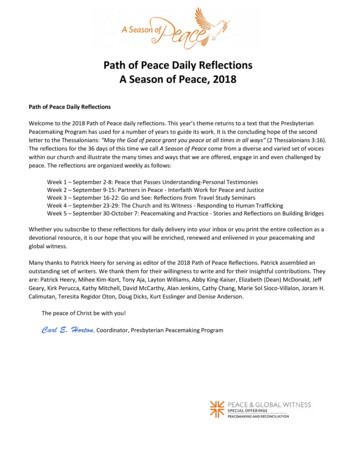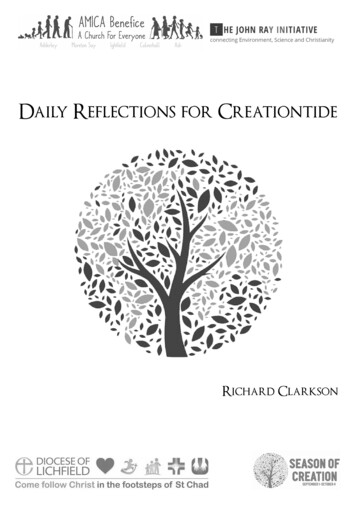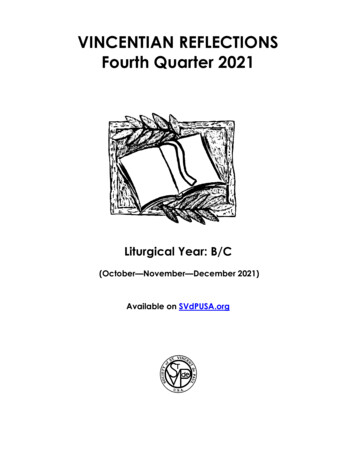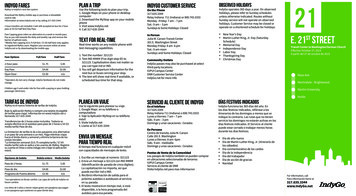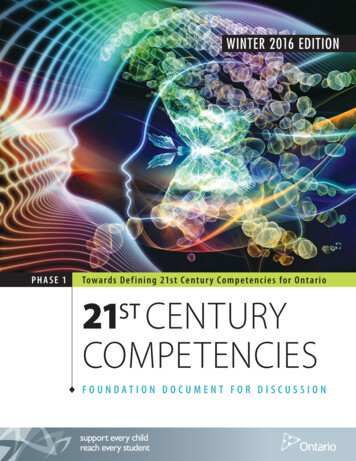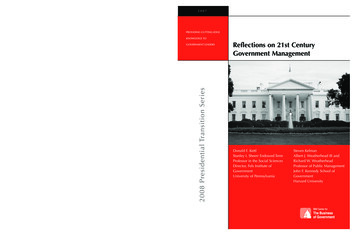
Transcription
2007providing cutting-edgeknowledge togovernment leadersReflections on 21st CenturyGovernment ManagementThrough research stipends and events, the IBM Center forThe Business of Government stimulates research and facilitatesdiscussion of new approaches to improving the effectiveness ofgovernment at the federal, state, local, and international levels.The Center is one of the ways that IBM seeks to advanceknowledge on how to improve public sector effectiveness.The IBM Center focuses on the future of the operation andmanagement of the public sector.About IBM Global Business ServicesWith consultants and professional staff in more than 160 countriesglobally, IBM Global Business Services is the world’s largestconsulting services organization. IBM Global Business Servicesprovides clients with business process and industry expertise,a deep understanding of technology solutions that addressspecific industry issues, and the ability to design, build andrun those solutions in a way that delivers bottom-line businessvalue. For more information visit www.ibm.com.For additional information, contact:Mark A. AbramsonExecutive DirectorIBM Center for The Business of Government1301 K Street, NWFourth Floor, West TowerWashington, DC 20005(202) 515-4504, fax: (202) 515-4375e-mail: businessofgovernment@us.ibm.comwebsite: www.businessofgovernment.org7180-1 IBM Kettl-Kelman Cvr.indd2-3 2-32008 Presidential Transition SeriesAbout the IBM Center for The Business of GovernmentDonald F. KettlStanley I. Sheerr Endowed TermProfessor in the Social SciencesDirector, Fels Institute ofGovernmentUniversity of PennsylvaniaSteven KelmanAlbert J. Weatherhead III andRichard W. WeatherheadProfessor of Public ManagementJohn F. Kennedy School ofGovernmentHarvard University1/12/07 9:44:06 AM
7180-1 IBM Kettl-Kelman Cvr.indd4-5 4-51/12/07 9:44:06 AM
2008 Presidential Transition SeriesReflections on 21st CenturyGovernment ManagementDonald F. KettlStanley I. Sheerr Endowed Term Professorin the Social SciencesDirector, Fels Institute of GovernmentUniversity of PennsylvaniaSteven KelmanAlbert J. Weatherhead III and Richard W.Weatherhead Professor of Public ManagementJohn F. Kennedy School of GovernmentHarvard University
TA B LEO FC ONTENTSForeword.4The Next Government of the United States: Challengesfor Performance in the 21st CenturyBy Donald F. Kettl.7Executive Summary.9Shifting Boundaries.10Periodic Revolution.10The Next Government of the United States: A Portrait.12A Policy Agenda That Focuses More on ProblemsThan on Structures.12Political Accountability That Works More Through ResultsThan on Processes.12Public Administration That Functions More OrganicallyThan Rigidly.13Political Leadership That Works More by Leveraging ActionThan Simply by Making Decisions.14Citizenship That Works More Through EngagementThan Remoteness.15The Government of the Future: Dr. Julie Gerberdingat the CDC.16Anthrax.16SARS.18CDC as a Learning Organization.18Creating the Government of the Future.22The Imperative for Knowledge-Driven Organizations.22The Increase in Non-Routine Problems.23The Growing Need for Non-Hierarchical Solutions.24Conclusion.28Endnotes to Kettl Essay.29About Donald F. Kettl.31Contact Information for Kettl.32
The Transformation of Government in the Decade AheadBy Steven Kelman.33Introduction.34The Challenge: Focusing on Performance in the First Place.36Performance Orientation for Government:The Battle Within Academia.37What Might the Next Decade’s Trends Be(If We Get to Focus on Performance)?.40Performance Measurement and Management.40Improved Contract Management.43Interorganizational Collaboration .45Choice and Competition.48Efficiency-Promoting Budget Reforms.50Endnotes to Kelman Essay.53Bibliography for Kelman Essay.56About Steven Kelman.62Contact Information for Kelman.63
Reflections on 21ST century government managementF o r e w o r dOn behalf of the IBM Center for The Business of Government,we are pleased to present this report, “Reflections on 21st CenturyGovernment Management,” which contains essays by Donald F. Kettland Steven Kelman.In 2005, the IBM Center for The Business of Government began anambitious four-year project. Our goal is straightforward: to beginthinking about the future of government and the trends and new ideasin government management that a new president should consider as heor she takes office in 2009. The intent of this project is to stimulate newideas among several key audiences. We wish to spark the imaginationof government leaders to look beyond their day-to-day “urgencies” andreflect upon the important challenges the nation will face tomorrow.We also seek to challenge the academic and nonprofit communitiesto begin looking ahead to future approaches in the management ofgovernment as they continue to analyze past successes and failures.Albert MoralesOur approach to this project is simple: to engage the nation’s toppublic management thinkers in a discussion of the future of government management. We want to begin a national dialogue about “whathappens next.” The next president of the United States will face a verydifferent set of management challenges from the ones that confrontedthe current president when he took office. Can we collectively begin toanticipate these challenges and start preparing to respond to them?In 2005, we asked Donald Kettl (Stanley I. Sheerr Endowed TermProfessor in the Social Sciences at the University of Pennsylvania) togive us his thoughts on these questions. In 2006, we asked StevenKelman (Albert J. Weatherhead III and Richard W. WeatherheadProfessor of Public Management at Harvard University’s KennedySchool of Government) to respond to the same set of questions. Bothof their essays are presented in this volume. In preparing his paper,Professor Kelman had the benefit of reviewing Professor Kettl’s paperand reflecting on Kettl’s thoughts and ideas.Each paper was presented at a Thought Leadership Forum at the WyeRiver Conference Centers in Queenstown, Maryland. Professor Kettlpresented his paper at Wye in June 2005, while Professor Kelman IBM Center for The Business of GovernmentMark A. Abramson
Reflections on 21ST century government managementpresented his paper at Wye in June 2005, while Professor Kelmanpresented his at a second Wye River Forum in November 2006.Participants at the Forum included many of the nation’s leading thinkersand practitioners on issues related to government management. Paperssummarizing the insights developed at both Forums are available onthe Center’s website at www.businessofgovernment.org/transition2008.In addition, the Center staff developed a companion report on significant management trends based on the more than 160 reports theCenter has published over the past eight years. That report, Six TrendsTransforming Government, is also on the Center’s website. Look atit, as well, to see if these trends support or deviate from the insightsoffered in these essays.Our objective in publishing these two outstanding essays is to stimulate a nationwide dialogue on the future of management in government. In the “old days,” individuals could grumble about whetherthey agreed or disagreed with an author’s ideas. If highly motivated,they could write to an author and share their reactions and thoughts—but these thoughts remained solely with the author. Today, new technology allows us to engage a wide audience.So we would like your thoughts on the two essays by Professors Kettland Kelman. Did they get it right? Did they get it wrong? Did theyleave out an important idea? What are your thoughts on the future ofgovernment?Please go to www.businessofgovernment.org/transition2008 and joina virtual discussion on improving government management. We lookforward to your participation in our ongoing conversation.Albert MoralesManaging PartnerIBM Center for The Business of Governmentalbert.morales@us.ibm.comMark A. AbramsonExecutive DirectorIBM Center for The Business of vernment.org
The Next Government of theUnited States: Challenges forPerformance in the 21st CenturyDonald F. KettlStanley I. Sheerr Endowed Term Professorin the Social SciencesDirector, Fels Institute of GovernmentUniversity of Pennsylvaniawww.businessofgovernment.org
Reflections on 21ST century government managementE x e cu t i v eSumm a r yIn response to a request from the IBM Center forThe Business of Government, I prepared this essayin 2005 to stimulate a discussion on what the “nextgovernment” of the United States might look like.The discussion focuses on the following five imperatives for the performance of American governmentin the 21st century: A policy agenda that focuses more on problemsthan on structures Political accountability that works morethrough results than on processesPublic administration that functions moreorganically, through heterarchy, than rigidlythrough hierarchya series of challenges, including the 2001 anthraxattack and Severe Acute Respiratory Syndrome (SARS),and devised a new model for CDC’s operation. Thisessay concludes with an analysis of the steps she took,along with a broader discussion of the imperative forcreating knowledge-driven learning organizations.Based on Dr. Gerberding’s experiences, what general principles can be drawn from CDC’s issues thatwould be useful in creating the government of thefuture? Consider these three: The imperative for knowledge-drivenorganizations The increase in non-routine problems The growing need for non-hierarchical solutions Political leadership that works more by leveragingaction than simply by making decisionsCitizenship that works more through engagementthan remotenessThese imperatives emerge from America’s struggle todeal with deep challenges facing the nation. At thecore is a fundamental problem: The current conductof American government is a poor match for theproblems it must solve. If government is to servethe needs of its citizens in the 21st century, it mustreconfigure itself—to shift the boundaries of whodoes what and, even more important, how its workgets done.Government is moving into the information age.Effective government requires public institutionsthat can manage information to learn how bestto improve their effectiveness. In the informationage, democratic government demands both citizenengagement and transparency. However, the growing complexity of government’s administrative toolsmakes it far harder to determine who is responsiblefor what. Innovations in information—who producesit and who uses it—will be essential to crack thisemerging paradox of 21st century governance.Some public organizations have already experimentedwith the challenges of stretching and bridging theirboundaries. At the Centers for Disease Control andPrevention (CDC), Dr. Julie Gerberding struggled withwww.businessofgovernment.org
Reflections on 21ST century government managementShifting BoundariesAmericans have always been explorers and, as theyhave stretched their ambitions, they have always builtboundaries. “Good fences make good neighbors,”wrote Robert Frost in his poem “Mending Wall.”The urge to escape the boundaries of the east drovesettlers west—and one of the first things they did wasto construct fences. So it has been with Americansand their government. The Constitution’s long shadowover American democracy is one of boundaries:of what each branch of government is empoweredto do, of powers reserved to state governments,and, most important, on the limits of governmentalpower enshrined in the Bill of Rights.Yet, as Frost begins his famous poem, “Somethingthere is that doesn’t love a wall.” American governments increasingly face problems that pay littleattention to the boundaries created to manage them.Moreover, the boundaries with American government—and between its public institutions—havelong been porous. Indeed, the American separationof-powers approach is less a way of building fencesaround governmental institutions than of structuringthe political conflict between them. Having createdthe boundaries, we test them, and we test them often.Moreover, the relative power of American politicalinstitutions has shifted regularly throughout Americanhistory. Indeed, one of the greatest and leastappreciated strengths of American democracy isthe ability of its systems to stretch and accommodatenew political pressures without shattering the fundamental balance at the core.Periodic RevolutionThe constancy of change has been at the core ofAmerican government. Americans have always lovedto tinker. Benjamin Franklin’s many inventions camefrom puttering about in search of solutions to problems10IBM Center for The Business of Governmenthe observed. For more than 40 years, Thomas Jeffersoncontinually redesigned and rebuilt his belovedMonticello. The administrative structure of Americangovernment has followed much the same pattern.Throughout the 20th century, as Paul C. Light describes,American government was awash in tides of reform,which regularly sought to transform how governmentdid its work.1 A driving culture of pragmatism haslong been at the core of American political culture.Beyond the constancy of change, however, lie moreperiodic, revolutionary transformations. Americanhistory has been marked by “punctuated equilibriums,” deep, fundamental, and sometimes violentchanges that have interrupted the steady wash ofreformist tinkering.2 They have come as earthquakelike changes, along deep fault lines in the politicalsystem. Three fault lines have long proven to be themost important:Federalism. In the early decades of the Americanrepublic, the nation slid around fundamental questions of the balance of power between the federaland state governments. The Articles of Confederationput power in the states, but the young nation provedincapable of organizing itself to solve tough problemslike security in the countryside and trade amongneighboring states. The Constitution firmly stated inthe 10th Amendment: “The powers not delegated tothe United States by the Constitution, nor prohibitedby it to the States, are reserved to the States respectively, or to the people.” But where the boundaries layproved a long-simmering problem. Slavery was theflash point, but there were important economic andsocial forces as well that built up tension along thisfault line. The earthquake came with the Civil War,which resolved the tensions, if uneasily, in favor offederal supremacy.
Reflections on 21ST century government managementPrivatization. The American Revolution was in partabout the colonists’ revolt against the king’s effort torestrain commerce. The Boston Tea Party, after all,was an act of vandalism by Bostonians against shipsowned by the British East India Company, which theBritish government had tried to aid through a specialtax plan. Americans wanted freedom of commerce,which they largely got until the Industrial Revolution.Toward the end of the 19th century, tensions beganbuilding on the role of the free market. Market-basedcompetition increasingly hurt citizens, from unregulated steamship boilers that exploded to large truststhat gained monopoly control over the marketplace.Americans demanded tougher controls on business.The earthquake came with the Progressive Era, whichushered in new restrictions and a new role for government, from governing the value of money throughthe Federal Reserve to regulating markets throughindependent regulatory agencies.Globalization. Once they fought off the British crown,Americans largely contented themselves with conquering the vast land that stretched to the Pacific.They showed little interest in the battles that so oftenpreoccupied Europe, until World War I drew theminto a conflict they could not escape. When the warended, they settled back into a happy isolationismthat even Hitler’s invasion of Europe did not shake.The tensions finally proved overwhelming whenJapanese forces attacked Pearl Harbor. The earthquake redefined America’s role in the world andmade it a central player on the global stage.As the New York Times editorialized on September12, 2001, “We look back at sunrise yesterday throughpillars of smoke and dust, down streets snowed underwith the atomized debris of the skyline, and we understand that everything has changed.”3 Everything, ofcourse, had changed—but in fact the change hadoccurred before 9/11. We just had not realized it.It took the earthquake of 9/11 to point out the transformations that had already taken place.For the first time in American history, all threeboundaries moved at once. In federalism, the political and administrative revival of the American statesbrought them into far greater prominence in domestic policy, just as political gridlock paralyzed federalpolicy makers. In privatization, the rise of freemarket capitalism and deregulation spurred a riseof corporate power the likes of which the nation hadnot seen for a century. In globalization, importantchanges occurred: the fall of communism, America’srise as the world’s unchallenged military power, thegrowing importance of global economic markets, andthe unexpected challenge of global terror networks.Americans found themselves, for the first time ever,struggling to redefine the boundaries of federalism,privatization, and globalization—simultaneously.That frames the fundamental question. Followingthe earthquake that occurred at the beginning of the21st century, how is the political landscape beingtransformed? Toward what is American governmentmoving? Indeed, what is the next government of theUnited States?Throughout American history, tensions have period ically built up. The existing boundaries provedunworkable, and no amount of tinkering couldresolve the problem. When American governmentproved it was not up to the problems it had tosolve—and when the costs of the strain provedunacceptable—an earthquake in governmentoccurred, and a new government arose to replace it.These earthquakes have come with surprisinglyregularity: the Civil War in the 1860s, followed bythe limits on free markets led by the Progressives inthe 1900s and 1910s, and then the rise of Americanglobal power in the 1940s and 1950s. By the endof the 20th century, the nation was overdue foranother fundamental shift. And, sure enough, the9/11 terrorist attacks brought a stunning earthquake.www.businessofgovernment.org11
Reflections on 21ST century government managementThe Next Government of theUnited States: A PortraitJust what might the next government of the UnitedStates look like? We can imagine five imperatives fora new and more effective strategy of government.A Policy Agenda That Focuses Moreon Problems Than on StructuresNot long after watching a television newsmagazinereport on the risks of sport-utility-vehicle rolloveraccidents, the author just missed watching such anaccident. Coming upon the scene moments later,he saw an SUV on its roof on the side of the road.As luck would also have it, the occupants were nothurt—but they were hanging upside down by theirseatbelts. But as luck would also have it, the accident was precisely at the intersection of two localgovernments. It was anything but clear whose job itwas to get those people out.In a case like that, three things could happen, andtwo of them would be bad. Neither governmentmight respond, with each assuming the other wouldhandle the call, and the victims would remaintrapped. Both governments might respond with thefull first-response arsenal, and taxpayers would havepaid twice for the same service. Fortunately, thethird alternative was the one that occurred. Becauseboth communities had worked out these problemsin the past, emergency vehicles with sirens wailingconverged on the scene from both directions—with just the right level of support. They managedto extract the occupants from the vehicle, and theymade the critical point: When you are hangingupside down from your seatbelts in a rolled-overSUV, the last thing you care about is the name onthe decal on the side of the emergency vehicle.People want their problems solved; they don’t fussover who solves them. In the United States, it has12IBM Center for The Business of GovernmentFive Imperatives for thePerformance of American Governmentin the 21st Century A policy agenda that focuses more on problemsthan on structures Political accountability that works morethrough results than on processes Public administration that functions moreorganically, through networks, than rigidlythrough hierarchy Political leadership that works more by leveragingaction than simply by making decisions Citizenship that works more through engagementthan remotenessbeen called “one-stop shopping.” In the UnitedKingdom, it is “no wrong door” and “joined-upgovernment.” But the point is the same.Effective 21st century governments work to ensureseamless service delivery in which governmentsstructure their service delivery systems according tothe problems to be solved, not by focusing on theorganizations charged with solving them.Political Accountability That WorksMore Through Results Than onProcessesCreating such integrated service systems demandsa mechanism for holding managers accountable for
Reflections on 21ST century government managementtheir actions. If government’s service system resemblesa web more than a hierarchy, who is responsible forwhat? If the government is part of a broader network,is government just one player among many, oneclaimant at a table with multiple claims on all sides?Who steers the network—if, in fact, the network isbeing steered? Who safeguards the public interest—and how can it best be done?Governments in Arlington County and throughoutthe region had long anticipated the possibility of amajor attack, had worked out possible scenarios inadvance, and had drilled with each other on howto respond. They did not have to work out tacticson the spot. Instead, they were able to shift intopre-arranged patterns, which made the response farsmoother.The answer to these questions traditionally camethrough hierarchy, but, as we have seen, the conductof 21st century government directly challenges thisapproach. We certainly are not about to abandonauthority as the cornerstone of public administration.Nor should we. Elected officials and citizens alikehave the right to expect to hold administratorsaccountable for the performance of public programs.But the more we rely on network-based service systems, the more we need approaches to accountabilitybeyond hierarchy to ensure that public agencieseffectively manage public programs.Emergency responders typically call this problem“interoperability,” but it extends far past establishingcommon procedures, command structures, communication systems, and other details like fire hosesthat actually connect to different cities’ hydrants.These straightforward elements have challengedmany communities. But interoperability extends tothe process of ensuring that public organizationswork together carefully and seamlessly.Where authority falls short, information systemsand performance management can help fill in thegap. These techniques surely cannot replace thebedrock approaches to accountability. However,techniques like the New York City Police Department’sCompStat system and the “Virginia Performs” systemoffer supplemental approaches for bridging the gapsthat authority fails to cover. Moreover, since organizational partnerships can shift and evolve rapidly,government needs a flexible accountability systemthat can keep up.Effective 21st century government requires a highperforming government whose accountability systemskeep track with the evolution of the public sector’stoolbox.Public Administration That FunctionsMore Organically Than RigidlyThe analyses of how government responded to the9/11 attacks showed the deep pathologies of publicorganizations trapped in functional silos. In NewYork City, for example, the emergency responsesystem suffered from a host of problems, includingcommunications breakdowns and deep strains incoordinating police and fire units.4 At the Pentagon,by contrast, the story is remarkably different.5There are huge challenges to this approach. Suchcoordination often fails because it is an unnaturalact among non-consenting bureaucrats. Indeed, oneof the first things that Arlington County Police ChiefEd Flynn had to do that morning was to decide thathe would surrender command over the crime sceneto firefighters, who were struggling to contain theblaze at the Pentagon. The Arlington emergencyresponse succeeded because administrators had,in the past, worked out such arrangements so theywere ready in case of trouble.But working out such relationships is often difficultbecause organizational boundaries often mirror thejurisdiction of legislative committees and subcommittees, and sharing power among legislative jurisdictions is a feat of supreme difficulty. AmericanEnterprise Institute analyst Norm Ornstein hascounted 88 different congressional committees andsubcommittees with some jurisdiction over the newDepartment of Homeland Security. That politicalfragmentation makes it increasingly hard to ensureadministrative coordination.Nevertheless, effective 21st century governmentrequires new mechanisms for coordinating government agencies to ensure that they connect organically as they seek to solve the manifest problemsthey confront.www.businessofgovernment.org13
Reflections on 21ST century government managementPolitical Leadership That Works Moreby Leveraging Action Than Simply byMaking DecisionsThe challenges facing 21st century governmentdemand more than innovative policy tools and freshadministrative approaches.6 They also demand newleadership by elected officials. It is unreasonablefor elected officials to promise more than they candeliver in homeland security, just as it is unconscionable for them not to try as hard as they can toprotect citizens. It is unthinkable for them to demandaccountability from administrators at the same timethey might be creating obstacles to performance.The challenges demand a higher level of truth-tellingfrom elected officials, truth-telling that rises abovea promise not to dissemble, to a commitment toengage citizens in a frank debate about the realitiesof what government should and should not seek,and what it can and cannot do.Too often, media exposés prompt witch hunts toensure problems never happen again. That sometimes prompts government to act without exploringthe full consequences of its decisions—or withoutexamining related fallout. When studies showed thatthe use of the painkiller Vioxx was associated withheart attacks and strokes, public uproar led the manufacturer, Merck & Co., to withdraw the drug fromthe market and the Food and Drug Administrationto issue a public advisory. Some patients who foundrelief only with Vioxx countered that the decisiondramatically lowered their quality of life. Someresearchers pointed out that the cardiac risks ofVioxx were relatively low and that other painkillers sometimes caused serious bleeding problems.Reporters, citizens, and policy makers often look forblack-and-white answers to questions that live onlyin shades of gray.The highly combative, closely balanced politicalsystem can make elected officials gun-shy aboutwading into such complexity. The last two presidential elections have shown just how deeply dividedthe public is, and that has made it even harder forelected officials to deal with the inevitably complexissues they face—and to escape the gridlock thatso often constrains American politics. The problemgoes even deeper, however. Although the nation ispolitically balanced on a razor’s edge, there are relatively few states whose governments are so evenly14IBM Center for The Business of Governmentdivided. Within
reFleCtions on 21st CentUry GovernMent ManaGeMent F o r e W o r d on behalf of the iBM Center for the Business of Government, we are pleased to present this report, "reflections on 21st Century Government Management," which contains essays by donald F. Kettl and steven Kelman. in 2005, the iBM Center for the Business of Government began an
